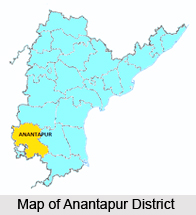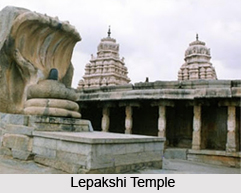 Anatapur is a place that blends history and modernity on one side and pilgrimage and forts on the other-side. Puttaparthi, the home of Sri Satya Sai Baba, believed to be the reincarnation of Shirdi Sai Baba, is located in Anantapur. The 550-year-old banyan tree that is mentioned in the Guiness Book of World Records for its enormous size is found here. Lepakshi temple is the famous tourist attraction of this district. Anantapur is known for its silk trade in the modern industry. Anantapur is the hometown of former President of the Republic of India, Shri Neelam Sanjeeva Reddy.
Anatapur is a place that blends history and modernity on one side and pilgrimage and forts on the other-side. Puttaparthi, the home of Sri Satya Sai Baba, believed to be the reincarnation of Shirdi Sai Baba, is located in Anantapur. The 550-year-old banyan tree that is mentioned in the Guiness Book of World Records for its enormous size is found here. Lepakshi temple is the famous tourist attraction of this district. Anantapur is known for its silk trade in the modern industry. Anantapur is the hometown of former President of the Republic of India, Shri Neelam Sanjeeva Reddy.
Origin of name of Anantapur
It is believed that the place got its name from `Anaatasagaram`, which was a big tank in Ananatapur that means "Endless Ocean". Some assert that the city was named after the queen of Anantarasa Chilkkavodeya, the former ruler while some say that the place has been named after Anantarasa himself.
Geography of Anantapur
Anantapur is a city in the Andra Pradesh state of India. It is located at the western most part of Andhra Pradesh. It is the largest district of Andhra Pradesh that spreads over an area of 19,130-sq-kms. The city is bounded on the north by Kurnool, on the east by Cuddapah and Chittoor and on the south and west by Karnataka State. The major rivers of the city are Penna, Chithravathi, Vedavathi or Hagari, Papagni.
The climate of Anantapur is tropical. The temperature of summer varies between 30°C. - 40°C and the temperature of winter varies between 20°C. - 27°C. The rainfall of Anantapur is seasonal.
History of Anantapur
As per history, Anantapur was known as "Hande Anantapuram". The word `Hande` means chief. Anantapur and a few other places were gifted by the Vijayanagar rulers to Hanumappa Naidu of the Hande family. Anantarasa Chilkkavodeya, a Vijayanagar ruler constructed the villages of Anaantasagaram and Bukkarayasamudram.
The place came under the Qutub Shahis, the Mughals, and the Nawabs of Cuddapah. Although the Hande chiefs continued to rule as their subordinates, it was occupied by the Palergar of Bellary during the time of Ramappa. But the place was won back by his son, Siddappa. In 1757, Morari Rao Ghorpade attacked Anantapur. It is said that Siddappa bought off the enemy for Rs.50, 000.
 Anantapur then came under the possession of Hyder Ali and Tipu Sultan. It is said that Tipu hanged all the male members of the Siddappa family except Siddappa who escaped from his imprisonment at Srirangapatnam. After Tipu`s death, Anantapur was once again taken back by Siddappa. Siddappa submitted himself to Nizam because of the treaty of 1799, which took the total control of the area. Later he was pensioned off when British occupied the territory.
Anantapur then came under the possession of Hyder Ali and Tipu Sultan. It is said that Tipu hanged all the male members of the Siddappa family except Siddappa who escaped from his imprisonment at Srirangapatnam. After Tipu`s death, Anantapur was once again taken back by Siddappa. Siddappa submitted himself to Nizam because of the treaty of 1799, which took the total control of the area. Later he was pensioned off when British occupied the territory.
Culture of Anantapur
At Anantapur, there are thousands of centers, religious or secular where weekly, monthly and annual fairs are held. Every village in Anantapur has a place of worship where religious festivals are held. These places are visited by millions of devotees throughout the year. The rituals celebrated here are traditional, in accordance with the Agamas. The major festivals of Anantapur are Durgamma Festival, Sambhulingeswara Kalyanotsavam, Kotappakonda Temple Fair etc.
Demography of Anatapur
As per the 2001 census, the population of Anantapur is 3,183,781. The total literacy rate of the state is 42.18%. The sex ratio is 952females for 1000 males.
Transportation of Anantapur
Anantapur City is well connected to major cities by the National Highways 7 and 205. There is also direct train connection to Hyderabad, Bangalore, Mumbai, New Delhi, Ahmedabad, Jaipur, Bhubaneswar, Pune, Vishakapatnam, etc. Puttaparthi is the nearest airport with scheduled air services. For local transportation auto-rickshaws, taxis and city buses are available within Anantapur. Rental bicycles are also available.
Economy of Anatapur
The major crops cultivated at Anatapur are rice, jowar, cotton, maize, arhar, chillies, sesame, sugarcane. The major mineral stone of Anatapur is limestone.



















